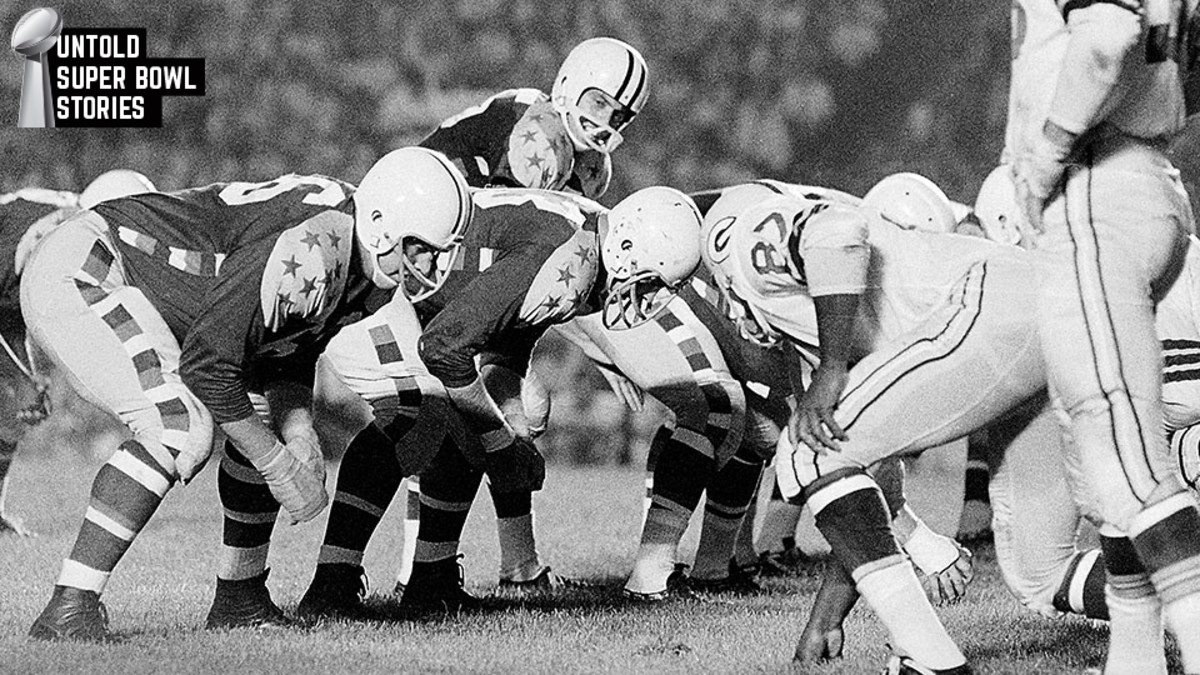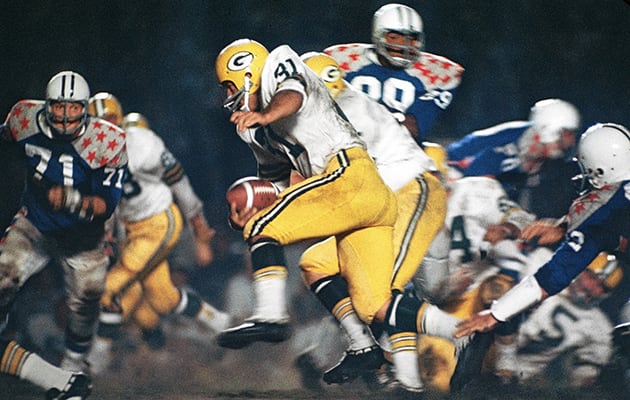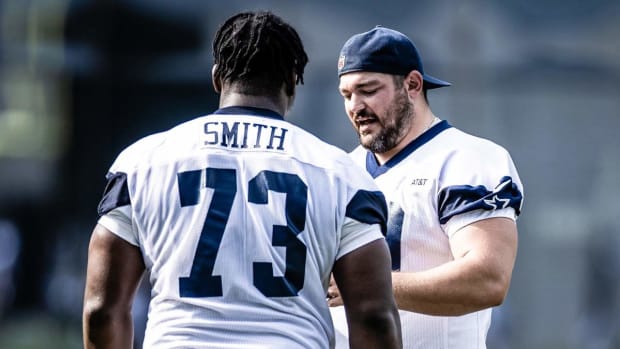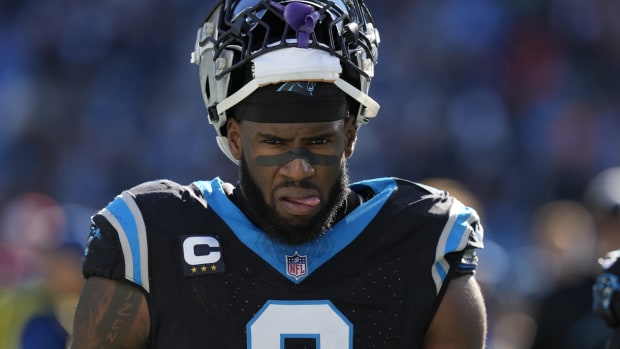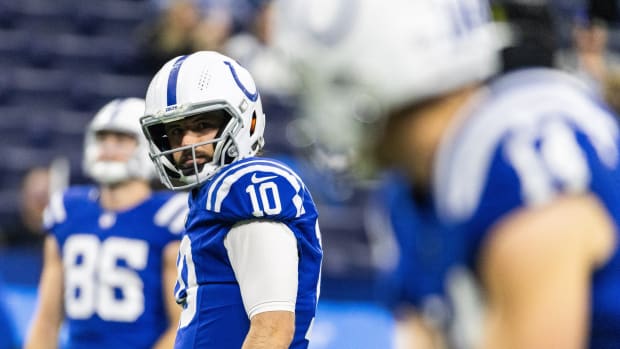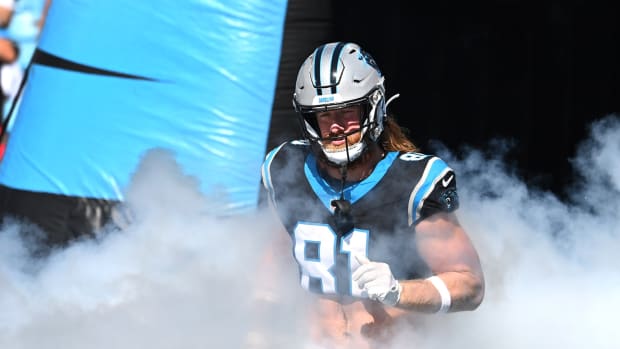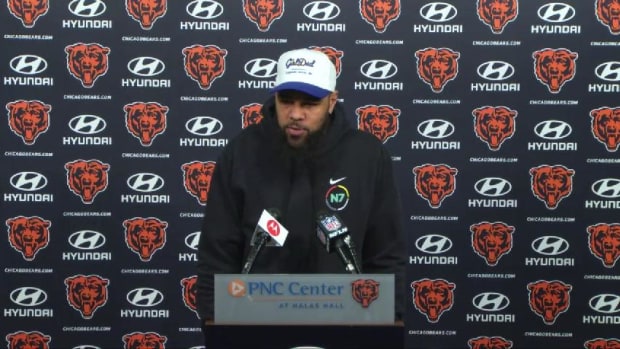When college all-stars faced off against reigning Super Bowl champs
As part of our countdown to Super Bowl 50, SI.com is rolling out a series focusing on the overlooked, forgotten or just plain strange history of football's biggest game. From commercials to Super Bowl parties, we'll cover it all, with new stories published every Wednesday here.
They say Chicago is absolutely lovely in August, if a bit on the sweltering side. But damned if Jackie Slater wanted to be there in the summer of 1976. He had no business being there. Truly.
Some four months had passed since the Los Angeles Rams plucked the 22-year-old Slater out of Jackson State in the third round of the NFL draft and, still, no contract. “My agent,” recalls Slater, now 61, “wouldn’t even return my phone calls.” Shockingly, there was no rush to sign a 6'4", 260-pound guard-tackle who had cleared swaths in college for a runner named Walter Payton. There was no market for an iron man who would go on to block for seven 1,000-yard rushers over a staggering 20 pro seasons.
There was simply no heat on Slater—who would’ve taken a deal at just about any price—other than the unforgiving Midwestern sun. Making money matters more pressing: He’d just married a God-fearing optimist named Annie (who’s been at his side for almost 40 years now) and had little to provide her. “Everything I owned,” he says, “was in a green foot locker.”
The SI story that wasn't: Covering Super Bowl XXIX with the Hobo King
As Slater saw it, he should’ve been in Los Angeles battling for a spot in the Rams’ O-line rotation. Instead he was practicing (with little compensation beyond the daily mess hall meals) for something called the College All-Star Football Classic, a preseason exhibition between the nation’s top seniors and the reigning Super Bowl champions. In 1976, that title belonged to the Pittsburgh Steelers—they of the cannon-armed QB (a resplendent blond named Terry Bradshaw) and the impenetrable defense (aka the Steel Curtain). “From my recollection,” says Joe Greene, perhaps the greatest brick in that defensive wall, “it was different than a preseason game. [The pros] took it seriously. We definitely didn’t want to lose to a bunch of college kids.”
No wonder Slater wanted to get away. This was a nightmare matchup in the purest sense.
“NFL GUYS AGAINST SOME COLLEGE DUDES? YOU TALKING ABOUT A BASKETBALL GAME?” ASKS THE CHARGERS' MELVIN GORDON.
When we imagine what a football game between college all-stars and NFL pros might look like today, it’s a kid-friendly clash. The collegians always come from the most stacked college teams in history—the 1996 Huskers, the 2004 Trojans, the SEC’s flavor of the month—and they’re always facing an NFL laggard. It’s a pleasant enough fantasy, but it overlooks the harshness of what actually happened for a sizable chunk of the 20th century, when a hodgepodge of talented college standouts were routinely humiliated by some of the NFL’s all-time greatest teams.
It’s a history of child abuse that today’s young pros struggle to fathom. “NFL guys against some college dudes?” asks the Chargers’ Melvin Gordon, a rookie tailback who almost certainly would have qualified for such a game based on the rushing records he set at Wisconsin. “You talking about in a basketball game?”
Sorry, no. A regulation professional football game.
“And this is with helmets and shoulder pads?”
Yes.
“I think that’s just cruel and unfair,” says third-year San Diego linebacker Manti Te’o.
Te’o’s positions coach, Mike Nolan, has a different view. But then again he would. Nolan’s father, Dick (who passed away in 2007), figured prominently in four all-star games: first as a rookie halfback out of Maryland (in 1954), then as a world-champion defensive back on the Giants (’56) and finally as an all-star assistant (in ’74 and ’76, when he was with the 49ers). “I think my brother still has [my dad’s] jersey from when he was on the college side,” Nolan says. “And my other brother has [Dad’s] jersey from one of the Giants teams.” It’s one of those ensembles that straps underneath the gentleman’s area, Nolan explains outside the Chargers’ locker room while pantomiming the act of putting on this onesie. “I remember watching the game he coached in ’76—they called it due to lightning or something. I thought that was unusual. They never called any games.”
'I'm going to Disneyland!' How simple phrase became Super Bowl lore
Now, before you mark the 56-year-old Nolan for some sort of football Methuselah, we should clarify that he wasn’t around for the first College All-Star Football Classic, in 1934. That contest was the fever dream of Chicago Tribune sports editor Arch Ward. A wunderkind who’d previously served as the press secretary to Notre Dame coach Knute Rockne, Ward fancied himself less a journalist than a spectacle maker. In fact, it was his creation of the Golden Gloves boxing tournament and MLB’s own all-star game that would compel Chicago mayor Edward Kelly and Tribune publisher Robert McCormick to seek Ward’s help in staging an event that would run as a coda to the city’s world’s fair.
After huddling with Bears owner George Halas, who was a friend, Ward settled on the idea of an exhibition game between the country’s top college football players and the defending NFL champions—a matchup that, at the time, was more of a win-win for both sides. The amateurs, who didn’t yet have postseason bowl games as staples of their football diet, got a ready-made spectacle to sate their expanding audience and showcase their talents. The pros got a chance to convince a skeptical public that playing football for money wasn’t the joyless and corrupt endeavor that people like Rockne and Grantland Rice were constantly making it out to be.
To build up buzz, Ward introduced two set pieces that would become integral to the modern hype machine: a fan poll (some 165,000 Tribune readers voted to name the game’s 35 college all-stars and three coaches) and a philanthropic hook (profits would be divided among the United, Catholic and Jewish charities of Chicago). In a column that ran less than two months before kickoff, Ward wrote that the idea behind “the most unusual football game ever scheduled” was “to provide a few hours of wholesome recreation for those who wish to see the best talent American football can present.”
“CLEARLY, WARD HAD HIT ON SOMETHING. PEOPLE, IT SEEMED, WOULD COME OUT IN DROVES FOR THE MERE PROSPECT OF A GOOD MAULING.”
On Aug. 31, Halas’s 10-2-1 Bears met a collective of college standouts led by Purdue coach Noble Kizer at Soldier Field. That game, which ended in a 0–0 tie, was panned in one media outlet (presumably not the Trib) as “deadly dull.” And yet 79,000-plus spectators—a crowd three times larger than the one that had watched the same Bears beat the Giants in the NFL title game at Wrigley Field nine months earlier—showed up for it.
For the 1935 edition, Halas asked for and got a rematch, even though his Bears had lost the championship to the Giants after going 13–0 in the regular season. (It was the only instance of a non-title team being granted special dispensation.) Facing a star-studded group of amateurs led by Alabama coach Frank Thomas, Halas’s Bears won 5–0, their lone points coming on a 27-yard field goal and a fumbled punt that was recovered (by the punter) in the end zone for a safety. Some 77,000 fans turned up at Soldier Field for that one.
Clearly, Ward had hit on something. People, it seemed, would come out in droves for the mere prospect of a good mauling.
***
So it was in Roman times, when Christians were thrown to the lions. And so it was in August 1976, when Jackie Slater was stuck in Skokie, Ill., the northern-Chicago suburb to which the college all-stars had repaired to begin game-planning for a world-champion Steelers team that would go down as the first true dynasty of the Super Bowl era.
Slater could’ve cursed the Jackson State sports information director who volunteered his name for this spectacle, where he was, alas, the only amateur offensive lineman of color. Literally any other bowl game—and they were totally a thing by the 1970s—would’ve been better than this one. “I was very disappointed,” Slater says today from inside a bustling cafeteria at Azusa Pacific University, where he’s the O-line coach for the D-II Cougars. “I wanted play in the Senior Bowl because those guys got paid: Losers got $1,000, winners got $1,500 and the MVP got a car. I knew I didn’t have a chance at the car, but I had a chance at the dough. The good Lord knows I could’ve used it at the time.”
Instead, all he got was grief from the grumpy old man on the all-stars’ staff who was coaching the O-line. “I had no idea who he was, and I did not disrespect him in anyway,” says Slater, “but, boy, he got on my last nerve.”
The old man sent Slater out on errands. (Fetch us some pencils! Grab those bags!) He limited Slater to third-team reps and insisted that the rookie-to-be walk through them. “I’d never had a ‘step over here and touch somebody’ drill in my life,” says Slater. “Everything I’d ever done was full speed.”
Tracing the beginnings of the most exclusive car club in the world
By the second day of camp, Slater had enough. He was going to get himself some real reps, that miserable old man be damned. He told his defensive counterparts, “I’m coming off.” “That was the only warning,” he says now, giggling. When the ball was snapped, he exploded from his stance and—BOOM!—launched into the man before him. “You could hear those pads rockin’,” he says.
The din stirred the many NFL talent evaluators in the audience and sent them scurrying around this once hapless hazing victim. The old coach was jolted too. “Don’t do that again,” he growled at Slater.
“I’m thinking: ‘Oh my goodness, I done got on the wrong side of this guy just by playing football!’”
But Slater didn’t let up. Some part of him was determined to rebel, to get kicked clean out of camp. He took two more snaps in a scrimmage before the old coach subbed him out for the day.
The next morning, Slater hit hard again. This time the coach stopped practice. He rounded up his five biggest defensive linemen—a group that included Oklahoma defensive end Lee Roy Selmon, the No. 1 pick in the draft—and released ’em on the big fella. “Come on!” Slater raged. “You wanna hit somebody?”
The first two guys he walloped pretty good. The last three, including Selmon, Slater was too gassed to handle. Seizing on the opportunity to take out his go-fer for good, the coach called for a scrimmage and plugged Slater in at right guard. “He thought he was going to embarrass me,” Slater says. “But see, what he did not know was, now I’m in my element. I’ve worked up a lather. This is the only way I know how to practice.” And for the most part the Jackson State grad proved indomitable.
The following morning, the complexion of the all-star practices totally changed. Contact drills were full speed. Scrimmages were intense. Scouts showed up in advance, just to get a good view. Evidently, Slater had an effect on the old cuss, none other than Sid Gillman, the father of the modern-day passing game.
Several days before the game, the two men were hanging out in Gillman’s office, kibitzing like old pals, when Slater leveled with his coach. “Sid,” he said, “I appreciate all you’ve done for me, but I’m not gonna be here to play in this game.”
“Why?”
Slater gave him the whole spiel—the stillborn rookie contract talks, the recent nuptials, the green foot locker. “Listen,” Gillman said, “your contract is gonna get done. It’s gonna get worked out. The only thing I want you to think about is blocking Joe Greene.”
This is how Slater found out that he’d be starting in the last college all-star game.
***
“YOU PUT THOSE COLLEGE SCHEMES IN FRONT OF A GROUP OF GUYS WHO CAN JUST DOMINATE ONE-ON-ONE MATCHUPS ALL THE TIME? IT'S NOT GONNA WORK, BRO.” —MANTI TE'O
For five decades the collegians-versus-pros challenge in Chicago persisted, through the end of the Great Depression and the Second World War, though the Allied effort plundered talent equally from both sides. The college boys didn’t notch their first victory in the series until TCU’s Sammy Baugh tossed a 57-yard scoring bomb to upset Curly Lambeau’s Packers in the 1937 edition. One year later, the all-stars pulled off the upset again, 28–16, this time with Baugh on the opposite sideline, with the Redskins.
Three more amateur victories followed in the ensuing decade, the biggest coming in the 1947 edition when the all-stars scored on an 82-yard opening drive en route to shutting out the Bears, again, 16–0. A record crowd of 105,840 watched that game at Soldier Field, along with millions more on television. With the proliferation of the forward pass, the emergence of a rival pro league (another Arch Ward creation, the AAFC, in the ’40s) that grew the game outside the northeast and the midwest, and the introduction of the free-substitution rule, football had become more than mere “wholesome recreation.” It was a must-see event.
When the rookies triumphed in 1955 (over Paul Brown’s champs from Cleveland), it improved the all-stars’ record to 7-13-2—not bad for a bunch of novices. For some, the margins are even better if you factor in the moral victories. Among the studs on the losing side back in ’35 was a two-way player from Michigan named Jerry Ford. Decades later, in his autobiography, the former president would write that he considered the game “a moral victory and gratifying wind-up to my college career.” He even used the $100 all-star-game stipend that he received to help pay for transportation to his next stop, Yale Law School.
The scabs who paved the way for the Redskins’ 1987 Super Bowl title
But as the series rolled on, the pros’ experience proved overwhelming. Over the next 19 meetings they would drop just two games, the last in 1963, when Vince Lombardi’s Packers lost by a measly three points. Not surprisingly, the coach’s vengeance was fierce. Over three subsequent games, from ’66 through ’68, his teams outscored the all-stars 99–17.
It was just the kind of beatdown that today’s players expect these games would yield. And if they still played? The beatdowns would be even worse, they figure. Of course, for that to happen, organizers would have to somehow get around the very things that eventually wound up killing these incredible rivalry games: the threat of injury lawsuits, work stoppages, and competing exhibitions, like the Pro Bowl. “Coming out of college, I would probably take my chances [and play],” says Gordon, the Chargers’ rookie rusher. “But now that I know how smart these NFL guys are? I would not take my chances on that.”
Te’o, the San Diego linebacker, struggles to imagine playing against a bunch of college kids, knowing what he knows now. “It’s kinda like if at Notre Dame we had played against the best guys in high school,” he says. “We would obliterate them. It’s the same as if we had played guys in the NFL.
“Look at the strategy in the college game: Everybody has their own system—triple option, run and gun. . . . Why do they do that? They’re trying to get the upper hand; they think that by doing all these different things, they’ll win. But in the NFL, everybody runs the same offense, pro style. What’s that about? It’s about: I’ma line up and beat you one-on-one. You put those college schemes in front of a group of guys who can just dominate one-on-one matchups all the time? It’s not gonna work, bro.”
And yet, every so often the all-stars would manage to put a scare into the pros. After coming within a red-zone fumble and a goal line stand of offing the undefeated 1972 Dolphins—what an asterisk that would have made for!—the all-stars delivered another heart-stopper in ’75, when they fell to the Steel Curtain Steelers by a mere touchdown. Cal quarterback Steve Bartkowski, who accounted for both scores in the all-stars’ 21–14 loss, was named the game’s MVP. (Note: the pros always let the kids take that accolade.) Though Las Vegas bookmakers would install the Steelers as 17-point favorites in the ’76 game, all-stars coach Ara Parseghian, by then retired from Notre Dame, was undaunted. “I’m not afraid to stick my neck out,” he told the papers. “When the whistle blows, the All-Americans will be ready for the Steelers.”
“WHEN I GOT UP OFF THE GROUND AND WENT BACK TO THE HUDDLE, I KNEW WHY THEY CALLED HIM MEAN JOE GREENE. I WAS SCARED TO DEATH.” —JACKIE SLATER
The speech Parseghian delivered before the game was like nothing Slater had ever heard before. “He talked about how we were on the verge of realizing our dreams, how good we had been in college,” Slater says. By way of example, the coach pointed to Ohio State’s Archie Griffin: “You know how many men have won the Heisman Trophy two times? There’s no one on Pittsburgh that’s won the Heisman Trophy twice!” “I thought, ‘Man, I am really in the big leagues now,’” says Slater. “I mean, he had me ready to go!”
Of course, much of that adrenaline drained out of Slater the moment he walked onto the field and saw the Steelers calmly and confidently going about their business. Rah-rah speeches and coaching mind tricks hadn’t been features of Pittsburgh’s preparation. Mostly, recalls Greene, the Steelers just worked on keeping their execution and their health perfect.
Bud Bowl: The novel idea that forever changed Super Bowl commercials
So you can imagine how steamed the mountainous defensive tackle became when Slater, all lathered up again, started cut-blocking him. “Hey, man,” Greene snarled. “This is a preseason game. Stay off my knees, Slater.”
The rookie didn’t get the message. “When a guy would beg me off in college,” says Slater, “that’s when I’d be like: I’ve got him.” On another drive, Slater was working Greene on the backside of a play and dove at the defender again. “I went up—Foom!—and threw my body to the inside gap and hit him on his leg again.” Slater was laying flat on his stomach when he felt a tug on his shoulder pads. Mean Joe Greene is helping ME up! he thought. I got him! But just as Slater arose—Wham! Wham! Wham! Greene, Slater says, kicked him across the face. “Wholesome recreation” this was not. “When I got up off the ground and went back to the huddle, I knew why they called him Mean Joe Greene. I was scared to death.”
Greene, a much gentler giant these days at age 69, couldn’t dispute that account more softly. “Jackie likes to tell that story,” he says with a chuckle, “but it wasn’t like that. I didn’t kick him. I kicked at him—as a warning.” Whatever Greene did, Slater got the message, and he played on Greene’s terms as the Steelers rolled up a 24–0 lead. With 1:22 left in the third quarter, the all-stars had the ball on the pros’ 34. As third-string quarterback Jeb Blount called out a play—the Tulsa grad having been called upon only after the Steelers wiped out QB1 and QB2—a heavy northern wind blew in, bringing a sweeping rain and forcing Parseghian to call a timeout. As the conditions worsened, in a sequence that presaged Disco Demolition Night at Comiskey Park, spectators stormed the field, treating the artificial turf at Soldier Field like one big Slip ‘N Slide. “They were body surfing!” Greene recalls.
Fearing for the players’ safety, referee Cal Lepore sent the players to their dressing rooms in hope that the skies would calm and security would intervene. But after fans ripped down the goalposts, the game was called at 11:01 p.m. No MVP was named.
And with that the College All-Star Football Classic met an ignoble end. (The college boys’ final record: 9-31-2.) While the game’s spectacle-making legacy endures, the war stories and the respect that Slater earned are what mean the most to him today. Shortly after that game he flew out to L.A. to meet with Rams general manager Don Klosterman.
“You caused quite a stir in Chicago,” the GM said with an arched brow.
“I didn’t mean to cause any problems,” Slater started, fearing that his feather ruffling at all-star camp was about to come back and bite him. “What happened?”
Apparently, coach Gillman had called. Explained Klosterman: “He said to me, ‘Are you crazy? Not only do you have the best offensive lineman in this camp, but you might have the best lineman in your NFL camp. I would suggest you stop fooling around and get the guy’s contract done.’” Not long afterward, Slater had a deal. The next thing he did was fire his agent. “I knew at that point that it wasn’t about what an agent could do or say,” he says. “It was about what the player did—that’s what drove his market value.”
Three years later, after the Rams scrapped to a 9-7 finish and slugged their way through the playoffs, Slater again locked horns with Greene in Super Bowl XIV. To hear the Steelers D-tackle tell it, no one could touch Slater on that night in Pasadena—and not because he was cut-blocking again. He wasn’t. Recalls Greene: “He was blocking downfield on one run play; I think the runner gained about 15, 16 yards. And the whole time, Jackie was saying, ‘Thank you, Jesus; thank you, Jesus. . . .’ A shock came through me. I said to myself: ‘Oh my goodness; we can’t beat these guys and Jesus too. There’s no way.’”
In the end, divine intervention came in the form of one dropped Rams interception and a pair of Bradshaw TD bombs that helped the Steelers to a 31–19 victory and a fourth Lombardi Trophy. As time expired, Slater and Greene, the two giants, couldn’t help but gravitate toward each other. “There’s a picture of Joe and I walking off the field,” Slater says of the player he’d eventually follow into the Pro Football Hall of Fame. “And I’ve got this smile on my face, like, OK, yeah, you got me. And he’s got this bigger smile on his face like, Yeah, we really got you! Now, when I see Joe, I fold my hands and bow reverently. My first NFL start was against him in Chicago, in that all-star game. It was a monumental occasion.”
The likes of which we’ll never, ever see again.
































